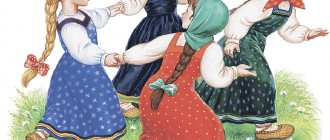A selection of Russian folk outdoor games for children of different ages
Folk games reflect the centuries-old history of the Russian people. Their rules are shaped by the way of life of our ancestors and reflect the character of the people. National games form in a child the ability to perceive world culture through the prism of the traditions of Russian culture.
Play is a huge, bright, gentle thing through which a life-giving stream of ideas and concepts about the surrounding world flows into the child’s spiritual world. Play is the spark that ignites the flame of inquisitiveness and curiosity.
V.A. Sukhomlinsky
“I give my heart to children”
Classic Russian folk games for children and adults
There are several outdoor games that originated in Russia several centuries ago, and today have become official sports.
Towns
Gorodki is a Russian folk game that originated in the 18th century, and in the 20th century it was recognized as a sport. It can be played by adults and children from the age of six. Towns contribute to the development of:
- dexterity;
- strength;
- eye gauge;
- composure;
- observation.
You can play one-on-one or team-on-team. The essence of the game is to try to knock out small formations (towns) made of five cylindrical columns from a limited area using a bat (stick). In this case, the bat is thrown from a certain distance. There are fifteen types of such constructions in total. The game must be played on a flat surface. For children the rules are modified. Usually the size of the bat and the distance from the thrower to the towns are reduced.
Gorodki is a native Russian game that children and adults enjoy playing
Lapta
The first information about the original Russian game called lapta is mentioned in ancient Russian writing. For several centuries in Russia, lapta was used for the physical development of children and adolescents. Today it is also used by teachers in physical education classes at school. But you can start teaching lapta to older children in preschool institutions.
In the classic version, it is played by two teams of 10 people. But by simplifying the rules, the number of participants can be reduced to two. Lapta develops:
- coordination of movements;
- dexterity;
- speed qualities;
- attentiveness.
To play you need a wooden bat, a tennis or rag ball, and a flat area (25x40 meters). At one end of the site, on the side of the shorter line, the house line is drawn, and at the other, the horse line. The first team occupies the house, and the second is located between these two lines. One first team player tosses the ball to his batsman. The latter must hit the ball and send it as far into the field as possible. After this, he must run behind the line and return. In this case, the players of the opposing team must catch the ball and try to mark the runner with it. Depending on the successful actions of the participants, teams are awarded points. Subsequently, the teams change places.
To play lapta you need a wooden bat and a small ball.
Games only for large numbers of participants
Most often, games require a large number of participants. Games are usually held in an open space. This is due to the fact that for centuries, in the absence of electricity, in their free time from work, on holidays, people gathered in their courtyards and spent their leisure time together.
Outdoor games from different countries
Would you be interested to know what children play in other countries of the world? I have always been interested in this question, so I began to collect information about it. So I have accumulated a small selection of foreign games. Interestingly, many of them have domestic analogues - and this once again proves that people are not so different from each other. At least in games. * *Greece: “Amalgata”** This game is reminiscent of our popular entertainment “The Sea is Troubled Once,” only in the Greek manner. Before starting the game, it is advisable to read the book “Myths of Ancient Greece” or at least tell some of them to your child. _Accessories:_ scarves, hats, brooches, sticks... - for player outfits. _ Rules of the game:_ The driver stands in the center of the court. He is blindfolded. He counts, and the other players walk around. After a while, the driver stops counting and loudly says: “Amalgate!” In Greek it means "statue". He takes off the blindfold and looks carefully at the players. At the same moment, all players should freeze in the pose of some ancient Greek hero. The presenter approaches each “statue” and looks closely to see if it is moving. If only the “statue” shakes or smiles, it is eliminated from the game. The most persistent player becomes the winner and becomes the leader in the next game. **Israel: “Go-gos”* * Go-gos in Israel are called apricot pits. They can be excellent projectiles for shooting range games. _ Accessories:_ apricot kernels, shoe boxes with different-sized holes cut into them. _Rules of the game:_ Before starting the game, you need to cut several holes in the lids of the boxes. One is the largest, the second is medium, the third is small (slightly larger than the bone itself). Each hole in the box has its own value: large - 10 points, medium - 15 points, small - 20 points. The boxes must be placed on the ground or floor, and a boundary line must be drawn one and a half meters from them. All players stand behind the line and throw the bones. The goal of the game is to get into the hole and score as many points as possible. The one who has more accurate hits and, accordingly, points wins. ** Argentina: “Tut-Tu Train”** A fun outdoor game, suitable even for those groups in which the children do not know each other. _Accessories:_ several (according to the number of players) pieces of chalk and a whistle. _Rules of the game:_ First, each player builds a personal depot: to do this, draw a small circle with chalk and stand in its center. The child will be a carriage at the depot. The driver stands in the middle of the playing area. He has a whistle in his hands. This is a steam locomotive. The locomotive does not have its own depot. He starts the game, slowly walks from one depot to another, and the cars (children) are attached to him. When the entire train is assembled (all the children stand behind each other), the locomotive speeds up. It is important for the carriages not to break away from the locomotive and keep up with it, no matter how fast they go. Suddenly the “locomotive” blows its whistle, at which point the “cars” must scatter around the depot. The “steam locomotive” also runs and takes over someone’s depot. A player who did not have time to join his depot circle is considered a loser and now he becomes a “locomotive”. **Korea: Bon Juggler** At first glance, this is a fairly simple game. However, the further you go, the more difficult, but also more interesting it is to play. _Accessories:_ 5 small smooth stones. _Rules of the game:_ The first player throws pebbles to the ground. He tries to throw them so that they lie as close to each other as possible. Then he picks up one pebble and throws it up. The player then picks up a second stone. He holds it in his hand and catches the first pebble on the fly. So the player ends up with two stones in his hand. He throws one of them again and at this time takes the third pebble. So he continues throwing stones until he has 5 stones in his hand. Second part: at this stage, the player must pick up two stones from the ground during the flight of the first pebble. At the next stage - 3 stones, then - 4. As a result, the player throws all 5 stones into the air and tries to catch them with his cupped hands. The number of pebbles the kid catches is the number of points he gets. The one who scores the most points wins. This game also exists in other countries under the name “Five stones” (Batu Seremban). Sometimes, instead of stones, specially sewn bags of rice or beans are used:
Red Rover
This game is a complete analogue of our “forged chains”. They usually play in an open area. Players stand in two lines opposite each other, at a distance of 5-7 meters, more is possible. In each line, players hold hands. Next, one of the teams says the following phrase: Red rover, red rover, we call (player's name) right over. The person whose name was called must leave his line and run towards the enemy’s line. The goal is to break one of the “links” of the other team’s chain. If the player manages to do this, he takes one of the players from the broken “link” to his team. If it doesn’t work out, he himself becomes a player on the other team. There are different variations of the game, one of them can be seen in the video.
In and Out the Dusty Bluebells
Another active children's game. Children stand in a circle, hold hands and raise them high up. One of the players begins to run between those holding hands, and at this time everyone sings the following song:
In and out the dusty bluebells, In and out the dusty bluebells, In and out the dusty bluebells, Who will be my master?
Tippy-tippy tap-toe on my shoulder, Tippy-tippy tap-toe on my shoulder, Tippy-tippy tap-toe on my shoulder, You will be my master.
With the words tippy-tippy tap-toe on your shoulder, the player stands behind the closest of those holding hands, puts his hands on his shoulders and, lightly patting them, finishes the song. The song begins to be sung again, only now there are two players running between those holding hands. This continues until all players are in the “snake”. I would say that this game is vaguely reminiscent of our “trickle”.
Pin the Tail on the Donkey
Another very funny game, the meaning of which is as follows: a drawing depicting a donkey without a tail is hung on a wall or some other hard surface. The players take turns blindfolded and given a paper tail. The player's task is to attach it to the correct place. You can see exactly what it looks like in the following video:
Sometimes, instead of a donkey, a drawing depicting Pinocchio without a nose is hung on the wall. The players' task is to attach the nose in place.
Blind Man's Buff
This children's game from England is similar to our outdoor game "panas" ("blind man's buff"). One participant is the presenter, he is blindfolded, spun in place and released. All other participants scatter to the sides, and the leader’s task is to catch them. At the same time, the players clap their hands so that the leader understands which direction he needs to move. This game is played both outdoors and indoors. It’s even more fun indoors: you have to use various tricks to avoid falling into the hands of the host.
British Bulldog
This is a tag-based game. British bulldog is an outdoor game, and it requires space, so an open place is chosen: a field or a playing field. There are no restrictions on the number of players: the more, the merrier. The essence of the game is this: depending on the number of players, one or two “bulldogs” are selected. They stand in the middle of the playing field, at this time all other players are “in the house” (home), that is, to the left or right of the “bulldogs” at some distance. The task of those “in the house” is to run to the opposite side and not be caught by the “bulldogs”. If this fails, the player himself becomes a “bulldog”. The one who manages to remain undetected the longest wins. Game details may vary slightly depending on region. For example, in the video below, the goal of the “bulldogs” is to snatch the scarves from the rest of the participants.
Hopscotch
And these are our good old classics. Squares are drawn on the asphalt with chalk in a certain sequence. The number of squares may vary, but usually no less than eight. The squares should be large enough to easily fit both feet. Players throw a small round object (a shooter), usually a pebble, onto each square in turn. Next, the player must jump onto each square with one or two feet, without stepping on its borders. If this rule is broken, the turn passes to the next player. The winner is the one who is the first to skip all the squares and return back to the starting point. Of course, there are different variations of the game.
Ring a ring o' roses
This game is most popular among young Britons, and is usually played in a kindergarten / a nursery school. Children dance in a circle and sing simple nursery rhymes:
Ring a ring o' roses, A pocket full of posies, Atishoo! Atishoo! We all fall down.
This happens as follows:
The game has a long and, according to some sources, very sad origins. An urban legend states that the game used to describe events occurring during the plague, but folklorists reject this explanation.
Conkers
The game of chestnuts is loved by both children and adults. Before I tell you exactly how it is played, I’ll tell you a little about preparation, because this game cannot be played without it. To get started you will need a chestnut, a screwdriver and a string. Using a screwdriver, make a hole in the middle of the chestnut. This must be done carefully so as not to get hurt. After the hole is made, you need to thread a lace through it so that it hangs literally 5-6 centimeters from the other end. After this you need to make a knot. Now your instrument is ready!
Now the rules of the game itself. Your goal is to destroy the enemy chestnut. Using the game “paper, scissors, rock”, they decide who will strike first. The loser of the rock-paper-scissors game holds his chestnut on a string while his opponent hits him with his chestnut. The person who strikes first strikes until he misses. Then it’s the second player’s turn. If during the game the laces get tangled, then the right to hit goes to the one who shouts Snags first. If your opponent's chestnut falls to the floor, you can shout out Stamps, which will give you the right to trample the chestnut and win the game.






